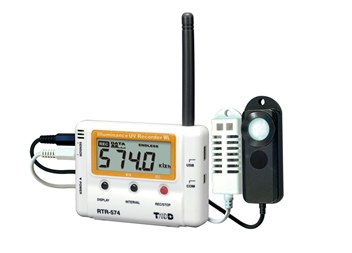CAS DataLoggers recently provided a real-time versatile monitoring solution for a museum housing fragile paintings and other artwork which needed to be protected against excessive illumination and ultraviolet light.
Both these threats could fade or change the color of paint and dyes, so the building needed to make sure their UV light filters and tinted panels were fully effective. Excessive temperature and humidity levels could also irreparably damage the museum’s collection. Existing installations and pieces in transport all required a compact, lightweight solution to record all the necessary parameters including temperature, humidity, wide-range illuminance, and UV light levels. The museum searched for a wireless real-time monitoring and alarming device which could ensure that all these parameters were closely controlled.
 4-channel wireless USB data logger from T&D.
4-channel wireless USB data logger from T&D.
The museum installed 5 T&D RTR-574 dataloggers on walls adjacent to the highest-traffic areas along with a T&D Wireless Data Logger USB Base Station in a hall nearby. Each data logger included 2 external sensors that simultaneously measured and recorded illuminance/UV intensity and temperature/humidity. The data loggers also calculated the cumulative illuminance and cumulative amount of UV light during recording sessions, which could both be viewed without stopping recording. The large, easy-to-read display allowed users to easily check the logger’s recording status, battery status, remaining data capacity and all types of measurements. Each datalogger also monitored temperature within a range of -0°C to 55°C (32°F to 131°F), and humidity levels from 10% to 95% RH. Wide-ranged illuminance measurements ranged from 0 to 130,000 lx, while the sensors also measured UV range from 0 - 30 mw/cm2.
While logging, users could select the recording mode as continual or for a specific duration. When using Endless Mode, upon reaching the logging capacity the oldest data was overwritten and recording continued. Each logger’s large memory capacity could store up to 8,000 data sets--one data set consisted of readings for all channels in that type of unit: Illuminance, UV intensity, Temperature, and Humidity.
The wireless base station linked wirelessly to the data loggers for downloading data--the wireless communication range, if unobstructed and direct, was about 150 meters (500 ft), and could be extended by registering another RTR-500 as a Repeater and placing it between a Base Station and a Remote or another Repeater. Simple, direct USB connection enabled users to quickly and easily download each datalogger’s data directly to a PC via USB cable. Since the office PC had more than one USB port, users could connect multiple data loggers at the same time. Users were also able to download recorded data and current readings from the remote units and send the data by e-mail or FTP--a warning report mail containing alarm details could be sent to up to 4 specified addresses. Additionally, by sending the recorded data to the T&D WebStorage Service, users could monitor all current readings and warnings online and also share the data via a PC web browser.
The museum’s real-time monitoring and alarming needs were all met by the T&D combination data loggers, which confirmed that the UV and illuminance controls remained effective in protecting the collection. Data transmission and accessibility were simplified by USB retrieval, while current readings were always available on the office PC via the online T&D webstorage service.